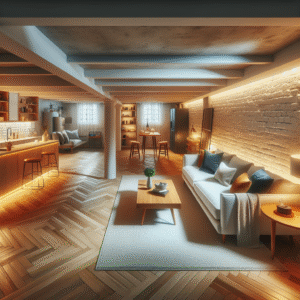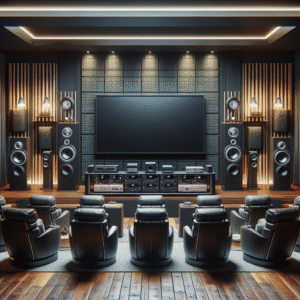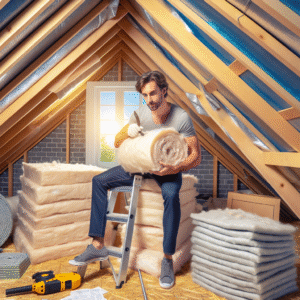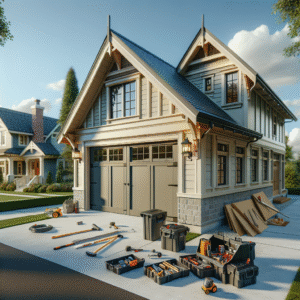Energy-efficient home renovations are one of the best ways to reduce your carbon footprint, lower your utility bills, and increase the overall value of your home. Whether you’re planning a minor update or a major overhaul, making your home more energy-efficient can have a lasting impact on your comfort and financial savings. The goal of energy-efficient renovations is to improve the way your home uses energy, from heating and cooling to lighting and water usage.
In this ultimate guide, we’ll explore everything you need to know about energy-efficient home renovations. From choosing sustainable materials to upgrading insulation and windows, we’ll cover practical steps and expert tips to help you create a more eco-friendly and cost-effective home.
1. Conduct an Energy Audit
Before diving into any renovation project, the first step to improving your home’s energy efficiency is to conduct an energy audit. An energy audit is a thorough assessment of your home’s energy usage and identifies areas where improvements can be made. By pinpointing energy inefficiencies, you can prioritize which upgrades will have the greatest impact.
How to Conduct an Energy Audit:
- Hire a Professional Auditor: A certified energy auditor will conduct a comprehensive inspection of your home, examining factors such as insulation, windows, heating and cooling systems, and air leakage. They will provide a detailed report with recommendations on how to improve energy efficiency.
- DIY Energy Audit: If you prefer a DIY approach, you can conduct a basic energy audit using tools like infrared thermometers to detect air leaks and thermal cameras to check for poor insulation. Look for drafts around windows and doors, check for uneven temperatures in different rooms, and assess your heating and cooling system’s efficiency.
By understanding where your home is losing energy, you can prioritize renovations that will provide the greatest return on investment.
2. Upgrade Insulation for Better Temperature Control
One of the most impactful energy-efficient upgrades you can make is improving your home’s insulation. Proper insulation helps maintain a consistent indoor temperature, reducing the strain on your heating and cooling systems and lowering your energy bills.
Key Areas to Insulate:
- Attic: Heat rises, which makes the attic one of the most important areas to insulate. Proper attic insulation can prevent heat from escaping during the winter and keep your home cooler in the summer.
- Walls: Insulating exterior walls can help reduce heat transfer between the inside and outside of your home. Depending on your wall structure, you can add blown-in insulation or rigid foam panels to improve efficiency.
- Floors and Crawl Spaces: Insulating floors, particularly those over unheated areas like crawl spaces or garages, can prevent heat loss and improve comfort. Insulating your crawl space will also help prevent moisture buildup and potential mold growth.
- Basement: If your home has an unfinished basement, adding insulation can help regulate temperature and improve overall energy efficiency.
Types of Insulation:
- Fiberglass Batt: One of the most common types of insulation, fiberglass batt is affordable and easy to install. It’s ideal for attics and wall cavities.
- Spray Foam: Spray foam insulation expands to fill gaps and cracks, providing excellent air sealing and insulation. It’s highly effective in hard-to-reach areas like crawl spaces and around windows.
- Blown-In Cellulose: Made from recycled paper products, blown-in cellulose is an eco-friendly insulation option that works well in attics and wall cavities.
- Rigid Foam Board: Rigid foam boards provide high insulation value and are commonly used for insulating walls, basements, and exterior applications.
Upgrading your home’s insulation is one of the most effective ways to improve energy efficiency and enhance comfort throughout the year.
3. Install Energy-Efficient Windows and Doors
Windows and doors are often major sources of heat loss in a home. Replacing old, drafty windows and doors with energy-efficient models can significantly reduce heat transfer, lower your heating and cooling costs, and improve the overall comfort of your home.
Benefits of Energy-Efficient Windows:
- Low-E Glass: Low-emissivity (Low-E) glass has a special coating that reflects heat back into your home during the winter and keeps it out during the summer. This reduces the need for heating and cooling, making your home more energy-efficient.
- Double or Triple Glazing: Double-glazed and triple-glazed windows have multiple panes of glass separated by air or gas, which acts as an insulator. This reduces heat transfer and helps maintain a consistent indoor temperature.
- Argon-Filled Windows: Windows filled with argon gas offer better insulation than those with just air between the panes. Argon is a non-toxic gas that slows down heat transfer, making your home more energy-efficient.
Energy-Efficient Doors:
- Insulated Exterior Doors: Insulated doors, especially those made from materials like fiberglass or steel, provide better thermal resistance than traditional wood doors. Look for doors with an ENERGY STAR rating for maximum efficiency.
- Weatherstripping: Adding weatherstripping around doors and windows can help seal gaps and prevent drafts. This simple upgrade can make a noticeable difference in reducing energy loss.
By installing energy-efficient windows and doors, you can dramatically improve your home’s thermal performance and reduce your reliance on heating and cooling systems.
4. Upgrade to Energy-Efficient Appliances
Appliances account for a significant portion of your home’s energy consumption. Replacing old, inefficient appliances with ENERGY STAR-rated models can greatly reduce your electricity and water usage, resulting in lower utility bills and a smaller carbon footprint.
Key Appliances to Upgrade:
- Refrigerators: Older refrigerators use significantly more energy than modern ENERGY STAR-rated models. New refrigerators are designed to consume less electricity while providing the same or better performance.
- Dishwashers: ENERGY STAR-rated dishwashers use less water and energy to clean dishes efficiently. Many models also offer eco-friendly wash cycles that reduce water consumption.
- Washing Machines: High-efficiency washing machines use less water and energy to wash clothes. Front-loading models are particularly efficient, using up to 40% less water than top-loading machines.
- Water Heaters: Tankless water heaters, also known as on-demand water heaters, heat water only when it’s needed, rather than maintaining a tank of hot water. This can lead to significant energy savings, especially in households with high hot water usage.
When shopping for new appliances, look for the ENERGY STAR label to ensure that you’re purchasing energy-efficient models that meet high environmental standards.
5. Install a Programmable or Smart Thermostat
Upgrading to a programmable or smart thermostat is a simple and cost-effective way to improve the energy efficiency of your home. These thermostats allow you to set temperature schedules based on your daily routine, ensuring that your heating and cooling systems aren’t running when they’re not needed.
Benefits of Programmable and Smart Thermostats:
- Energy Savings: By automatically adjusting the temperature when you’re away from home or asleep, programmable thermostats can reduce energy consumption and lower your utility bills.
- Remote Control: Smart thermostats can be controlled remotely using a smartphone or tablet, allowing you to adjust the temperature even when you’re not at home. This is especially useful if your schedule changes unexpectedly.
- Learning Capabilities: Some smart thermostats learn your habits over time and automatically adjust the temperature to optimize energy usage without sacrificing comfort.
By installing a programmable or smart thermostat, you can take greater control of your home’s energy use and enjoy more efficient heating and cooling.
6. Opt for Energy-Efficient Lighting
Lighting accounts for a significant portion of a home’s energy usage, but switching to energy-efficient lighting options can help reduce electricity consumption without compromising brightness or functionality.
Energy-Efficient Lighting Options:
- LED Bulbs: LED (light-emitting diode) bulbs are the most energy-efficient lighting option available. They use up to 75% less energy than traditional incandescent bulbs and last significantly longer.
- CFL Bulbs: Compact fluorescent light (CFL) bulbs are another energy-efficient option. While not as efficient as LEDs, they still use about 70% less energy than incandescent bulbs.
- Smart Lighting: Smart lighting systems allow you to control your lights remotely, schedule lighting changes, and adjust brightness levels. This can help you reduce energy waste by ensuring that lights are only on when needed.
Incorporating energy-efficient lighting into your home can lower your electricity usage and extend the lifespan of your bulbs, saving you money in the long run.
7. Choose Sustainable Building Materials
When renovating your home for energy efficiency, consider choosing sustainable building materials that have a lower environmental impact. Eco-friendly materials not only reduce the carbon footprint of your renovation but also improve the indoor air quality of your home.
Sustainable Material Options:
- Bamboo Flooring: Bamboo is a rapidly renewable resource that makes an excellent alternative to hardwood flooring. It’s durable, stylish, and environmentally friendly.
- Recycled Insulation: Insulation made from recycled materials, such as cellulose or denim, is an eco-friendly alternative to traditional fiberglass insulation. These materials provide excellent thermal performance and are often treated with non-toxic fire retardants.
- Low-VOC Paint: Paints that contain volatile organic compounds (VOCs) can release harmful fumes into your home’s air. Opt for low-VOC or no-VOC paints to improve indoor air quality and reduce environmental impact.
- Reclaimed Wood: Reclaimed wood is sourced from old buildings, barns, or factories, making it a sustainable choice for flooring, cabinetry, or furniture. It adds character and charm to your home while reducing the demand for new timber.
Using sustainable materials in your renovation project can help reduce waste, minimize environmental impact, and create a healthier living environment for you and your family.
8. Improve Water Efficiency
Water efficiency is a key component of energy-efficient home renovations, as reducing water usage can lower your utility bills and conserve this valuable resource. Upgrading your home’s plumbing fixtures and appliances can make a big difference in water conservation.
Water-Efficient Fixtures:
- Low-Flow Showerheads: Low-flow showerheads use less water without compromising water pressure, reducing your water usage while still providing a comfortable shower experience.
- Dual-Flush Toilets: Dual-flush toilets offer two flushing options—one for liquid waste and one for solid waste—allowing you to use less water when a full flush isn’t necessary.
- Water-Saving Faucets: Aerated faucets mix air with water, reducing water flow without sacrificing performance. They’re an easy and affordable upgrade for bathrooms and kitchens.
Greywater Systems:
Greywater systems collect wastewater from sinks, showers, and laundry machines and reuse it for irrigation or toilet flushing. Installing a greywater system can help reduce your household’s water consumption and make your home more sustainable.
9. Incorporate Renewable Energy Sources
Incorporating renewable energy sources into your home is one of the most impactful ways to improve energy efficiency and reduce your reliance on fossil fuels. While renewable energy systems require an upfront investment, they can provide long-term savings and environmental benefits.
Solar Panels:
Solar panels capture sunlight and convert it into electricity, reducing your dependence on the grid and lowering your electricity bills. Many homeowners can offset a significant portion of their energy usage with solar panels, especially in sunny climates.
Solar Water Heaters:
Solar water heaters use the sun’s energy to heat water for your home, reducing the need for traditional water heating methods. This can lead to significant energy savings, especially in homes with high hot water demand.
Wind Power:
In areas with consistent wind patterns, small wind turbines can generate electricity for residential use. Wind power can be a viable option for homeowners looking to supplement their energy needs with renewable resources.
By incorporating renewable energy sources, you can reduce your environmental impact, lower your energy bills, and increase your home’s energy independence.
10. Take Advantage of Energy Efficiency Incentives
Many governments and utility companies offer incentives for homeowners who invest in energy-efficient renovations. These incentives can come in the form of rebates, tax credits, or grants that help offset the cost of upgrading your home.
Common Incentives:
- Federal and State Tax Credits: Many countries offer tax credits for energy-efficient upgrades, such as installing solar panels, upgrading insulation, or purchasing ENERGY STAR appliances.
- Utility Company Rebates: Some utility companies provide rebates for homeowners who make energy-efficient improvements, such as upgrading HVAC systems, adding insulation, or installing energy-efficient windows.
- Energy-Efficient Mortgages: Some lenders offer energy-efficient mortgages (EEMs), which allow borrowers to finance energy-efficient upgrades as part of their home loan. EEMs can make it easier to invest in energy-efficient renovations.
By taking advantage of available incentives, you can reduce the upfront cost of your renovations and see a faster return on investment.
FAQ
1. How much can I save with energy-efficient home renovations?
The amount you can save depends on the scope of the renovations and your home’s current energy usage. On average, homeowners can save 10-30% on their utility bills by making energy-efficient upgrades.
2. How do I know which energy-efficient renovations to prioritize?
Start with an energy audit to identify the most significant sources of energy loss in your home. Common priorities include upgrading insulation, replacing windows, and installing energy-efficient appliances.
3. Are energy-efficient renovations worth the cost?
Yes, energy-efficient renovations typically provide a good return on investment by reducing utility bills, increasing home value, and improving comfort. Many renovations, such as upgrading insulation or installing solar panels, can pay for themselves over time.
4. Can I DIY energy-efficient home renovations?
Some energy-efficient upgrades, like adding weatherstripping or replacing light bulbs, can be done as DIY projects. However, larger projects, such as installing new insulation or replacing windows, may require professional expertise to ensure they’re done correctly.
5. How do I qualify for energy efficiency incentives?
Check with your local government and utility company to see what incentives are available in your area. Many programs require specific energy-efficient upgrades or appliances to qualify for rebates or tax credits.
Conclusion
Energy-efficient home renovations offer a wide range of benefits, from lower utility bills to a reduced environmental footprint. By upgrading insulation, windows, appliances, and lighting, you can make your home more sustainable and comfortable for years to come. Whether you’re conducting a full-scale renovation or making small improvements, the tips in this guide will help you prioritize the most impactful upgrades and maximize your energy savings.








